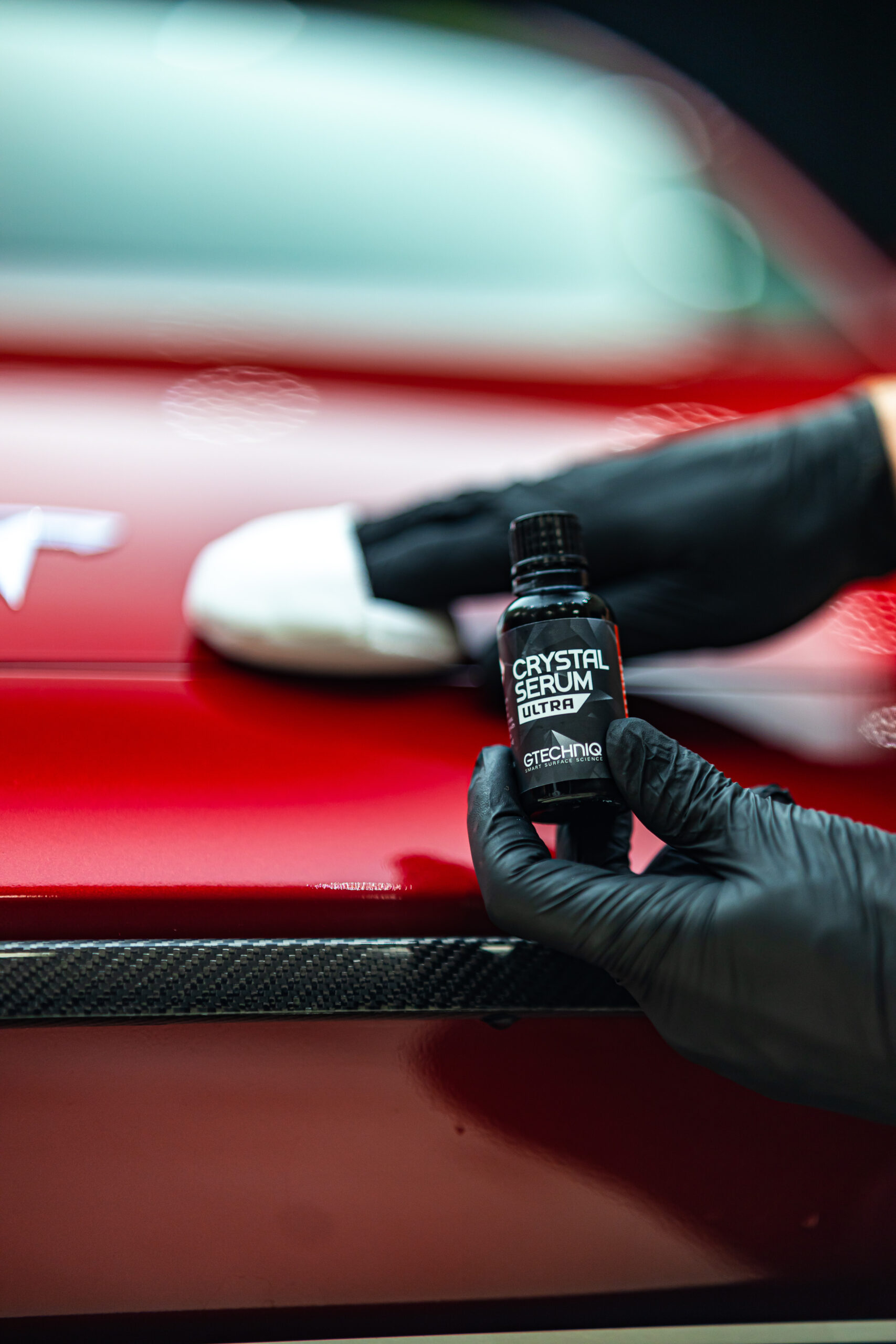Introduction
If you’ve ever admired a car with an unbelievably glossy finish, chances are you’ve seen the magic of ceramic coating in action. Ceramic coating has transformed the way we think about car care, offering a cutting-edge solution to protect and enhance your vehicle’s appearance. But what exactly is ceramic coating? How does it work, and is it worth the investment?
In this comprehensive guide, we’ll cover everything you need to know about ceramic coating, including its benefits, application process, common myths, and maintenance tips to keep your car looking brand new.
- Ceramic coating benefits
- Ceramic coating maintenance tips
- Professional ceramic coating services
What is Ceramic Coating?
Ceramic coating is a liquid polymer that, when applied to your car’s exterior, chemically bonds with the factory paint to form a long-lasting, protective layer. This layer is hydrophobic, meaning it repels water, and it also provides resistance to UV rays, chemicals, and light scratches.
Unlike traditional waxes or sealants, which simply sit on the surface, ceramic coating creates a semi-permanent bond with your car’s paint. This bond ensures that the coating remains effective for several years, providing superior protection compared to traditional options.
How Does Ceramic Coating Work?
- Bonding: The coating chemically adheres to the paint, creating a protective barrier.
- Sealing Imperfections: It fills in microscopic pores in the paint, creating an ultra-smooth surface.
- Hydrophobic Effect: The coating repels water and dirt, making cleaning easier.
Benefits of Ceramic Coating
1. Unmatched Paint Protection
Ceramic coating protects your car’s paint from environmental contaminants like:
- UV rays that cause paint fading.
- Acid rain that corrodes the surface.
- Bird droppings and tree sap that can leave permanent stains.
2. Hydrophobic Properties
One of the standout features of ceramic coating is its water-repelling ability. Water beads up and rolls off, taking dirt and grime with it. This property helps keep your car cleaner for longer and reduces water spots.
3. Enhanced Aesthetic Appeal
Ceramic coating enhances the depth and clarity of your car’s paint. The glossy finish adds a reflective, “wet look” that makes your car stand out.
4. Cost-Effective Investment
While the initial cost of ceramic coating may be higher than traditional wax or sealants, its durability makes it a cost-effective solution. With proper care, a single application can last 3-5 years or longer.
5. Ease of Maintenance
Ceramic-coated cars require less frequent washing and are easier to clean. Dirt and grime don’t stick to the surface, saving you time and effort.

The Process for Coating Essentials
The Application Process
Applying ceramic coating requires precision and attention to detail. Here’s a step-by-step look at the process:
Step 1: Surface Preparation
Before applying the coating, the car must be thoroughly cleaned to remove dirt, oil, and contaminants. A clay bar is often used to eliminate embedded particles.
Step 2: Paint Correction
If the car has scratches, swirl marks, or imperfections, they must be polished out. The ceramic coating will bond to the paint as it is, so a flawless surface ensures the best results.
Step 3: Application
- The ceramic coating is applied using a soft applicator pad in small, manageable sections.
- Each section is allowed to cure for a few minutes before being buffed off with a microfiber cloth.
Step 4: Curing Time
After the coating is applied, it needs time to cure fully. This curing period can range from 24 to 48 hours, during which the car should not be exposed to water or contaminants.
Here’s a long-form detailed blog about ceramic coating, structured to span more than two pages when published.
Maintenance Tips for Ceramic Coated Cars
Even though ceramic coating reduces the need for maintenance, proper care ensures its longevity. Follow these tips to keep your coating in top condition:
1. Regular Washing
- Wash your car at least once every two weeks using a pH-neutral car shampoo.
- Avoid using harsh chemicals or abrasive tools that could damage the coating.
2. Avoid Automatic Car Washes
The brushes in automatic car washes can cause micro-scratches, which may compromise the coating. Stick to hand washing with microfiber mitts.
3. Use a Maintenance Spray
Ceramic boosters or maintenance sprays can refresh the coating’s hydrophobic properties and restore its shine.
4. Remove Contaminants Promptly
Bird droppings, tree sap, and bug splatters should be cleaned off immediately to prevent etching into the coating.
5. Avoid Parking Under Direct Sunlight
While ceramic coating provides UV protection, excessive heat can still accelerate wear and tear. Whenever possible, park in shaded areas.
Common Myths About Ceramic Coating
Myth 1: Ceramic Coating Makes Your Car Scratch-Proof
Ceramic coating provides some resistance to light scratches but does not make your car completely impervious to damage. Deeper scratches or impacts still require professional repair.
Myth 2: Ceramic Coating Is Maintenance-Free
While ceramic coating reduces the frequency of washing and waxing, it still requires regular care to maintain its effectiveness and appearance.
Myth 3: Ceramic Coating is Permanent
Ceramic coating is long-lasting but not permanent. Over time, it will wear off and may require reapplication, especially in harsh climates.
Myth 4: DIY Kits Are as Good as Professional Application
DIY kits can offer some level of protection, but professional-grade ceramic coatings applied by experts provide a higher quality finish and longer-lasting results.
The Application Process
Applying ceramic coating requires precision and attention to detail. Here’s a step-by-step look at the process:
Step 1: Surface Preparation
Before applying the coating, the car must be thoroughly cleaned to remove dirt, oil, and contaminants. A clay bar is often used to eliminate embedded particles.
Step 2: Paint Correction
If the car has scratches, swirl marks, or imperfections, they must be polished out. The ceramic coating will bond to the paint as it is, so a flawless surface ensures the best results.
Step 3: Application
- The ceramic coating is applied using a soft applicator pad in small, manageable sections.
- Each section is allowed to cure for a few minutes before being buffed off with a microfiber cloth.
Step 4: Curing Time
After the coating is applied, it needs time to cure fully. This curing period can range from 24 to 48 hours, during which the car should not be exposed to water or contaminants.
Note: Professional application is recommended for the best results, especially if you’re new to ceramic coating.
Maintenance Tips for Ceramic Coated Cars
Even though ceramic coating reduces the need for maintenance, proper care ensures its longevity. Follow these tips to keep your coating in top condition:
1. Regular Washing
- Wash your car at least once every two weeks using a pH-neutral car shampoo.
- Avoid using harsh chemicals or abrasive tools that could damage the coating.
2. Avoid Automatic Car Washes
The brushes in automatic car washes can cause micro-scratches, which may compromise the coating. Stick to hand washing with microfiber mitts.
3. Use a Maintenance Spray
Ceramic boosters or maintenance sprays can refresh the coating’s hydrophobic properties and restore its shine.
4. Remove Contaminants Promptly
Bird droppings, tree sap, and bug splatters should be cleaned off immediately to prevent etching into the coating.
5. Avoid Parking Under Direct Sunlight
While ceramic coating provides UV protection, excessive heat can still accelerate wear and tear. Whenever possible, park in shaded areas.
Common Myths About Ceramic Coating
Myth 1: Ceramic Coating Makes Your Car Scratch-Proof
Ceramic coating provides some resistance to light scratches but does not make your car completely impervious to damage. Deeper scratches or impacts still require professional repair.
Myth 2: Ceramic Coating Is Maintenance-Free
While ceramic coating reduces the frequency of washing and waxing, it still requires regular care to maintain its effectiveness and appearance.
Myth 3: Ceramic Coating is Permanent
Ceramic coating is long-lasting but not permanent. Over time, it will wear off and may require reapplication, especially in harsh climates.
Myth 4: DIY Kits Are as Good as Professional Application
DIY kits can offer some level of protection, but professional-grade ceramic coatings applied by experts provide a higher quality finish and longer-lasting results.
Is Ceramic Coating Worth It?
If you’re looking for long-term protection and enhanced aesthetics for your vehicle, ceramic coating is an excellent investment. While it may have a higher upfront cost, the benefits far outweigh the expense in terms of durability, protection, and ease of maintenance.
Who Should Consider Ceramic Coating?
- Car enthusiasts who want their vehicles to stand out.
- Everyday drivers looking to protect their investment
- Those living in regions with harsh weather conditions
Conclusion
Ceramic coating is a revolutionary solution for car owners who want to protect their vehicles while keeping them looking immaculate. From its hydrophobic properties to its glossy finish, ceramic coating offers a level of protection and aesthetics unmatched by traditional methods.
Whether you choose to apply it yourself or hire a professional, the key to success lies in proper preparation and maintenance. By understanding how ceramic coating works and how to care for it, you can enjoy its benefits for years to come.




